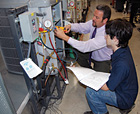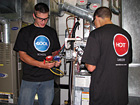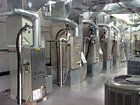NEW TECHNOLOGIES
Just as the emphasis on technology is changing the way companies do business, it is also changing the way teachers are interacting with students. Some instructors have found success using new technological tools in the classroom to foster learning.At Harrisburg Area Community College (HACC, Harrisburg, Pa.), the students use Simutech computer-based simulators for realistic training. According to Edward Burns, an HVACR instructor and the Technology Department chair at HACC, “Simutech allows the student to interact with the refrigeration and heating cycles on the computer.” Plus, he added, “The students do like this program.” This program is just one component of Burns’ “smart classroom,” which, he explained, “allows for more visual and Internet access.”

At the Upper Valley Joint Vocational School in Piqua, Ohio, instructor Tony Trapp (shown here with student) has worked with fellow instructor Scott Naill to increase enrollment in the HVACR program. Their program is currently at full capacity with a waiting list for the 2011-2012 school year.
At Bates Technical College in Tacoma, Wash., Mark Peila, HVACR instructor, said, “We have an electronic white board, document camera, interactive training software, PowerPoint presentations, and have switched to electronic testing. We are trying to keep up-to-date equipment with the latest industry technology in the program, but often it is cost prohibitive.”
One way to avoid added cost is to use free online technology, according to D. Brian Baker, founder and instructor of Westech Energy Training Center (Winnipeg, Manitoba). Baker has used Skype to interact with his students. Skype is a free web-based software application that enables users to have one-to-one video calls through webcams. “A recent bad weather event kept one of my students homebound, and we simply let him Skype in for the four-hour class,” Baker said. He added that some of his students have also begun to access him through his Facebook and LinkedIn profiles.
At the Upper Valley Joint Vocational School (JVS) in Piqua, Ohio, HVACR instructors Scott Naill and Tony Trapp are focusing even more on social media, which is another free way to use technology to interact with current and potential students. “On our front page of our website www.uppervalleyhvacr.com, we have embedded our Facebook and Twitter accounts,” Naill said. He explained, “This is a landing point for students, parents, and employers to interact and gather information about our program. This keeps all the stakeholders informed of any activities that occur throughout the week.” He added that some of the students currently enrolled in the HVACR program are also writing weekly blogs “about their life as a high school HVACR student.”

In response to low enrollment at Upper Valley JVS, instructors have used innovative marketing techniques to brand their program, like these “Cool School Hot Career” logo T-shirts.
ENROLLMENT & RECRUITMENT
Concern about the younger generation not being aware of or interested in the HVAC trade has long been a hot topic of discussion in the industry. Although some instructors are concerned about enrollment rates, several reported that their programs have steady or increasing enrollment. Yet even as enrollment rises, instructors continue to worry about the quality of students entering their programs.According to Mattiaccio, “My program is dying because the high school counselors are pushing the kids towards academic colleges rather than the trades.” He added that he is working to get local contractors involved in supporting the program.
“The demand for quality HVACR technicians is going to increase as the Baby Boomers enter retirement,” Peila said. He said he has been fortunate that demand for the program at Bates Technical College has remained steady. “Typically I have a six-month to two-year wait list,” he noted. He also added that the worse the economy is, the higher the demand for the program.
Another factor that tends to increase demand for HVAC programs is their affordability. “We constantly try to recruit students, but find students coming to us mainly because we are a community college (lower rates) and we do have a good reputation for our HVAC program,” Burns said. He continued, “We have full enrollment, and actually had to open more sections in some courses since they filled the first day of enrollment for the summer and fall terms.”
For successful programs to remain at full enrollment, instructors have always relied heavily on word of mouth. According to Tony Jordan, HVACR instructor at Blackhawk Technical College (Janesville, Wis.), “Generally, word of mouth and past student endorsements have worked well for us.”
He added, “We need to recruit students that are not only mechanically inclined but also good problem solvers that have the ability to learn the newer technologies. We can’t continue to be the dumping ground for the high school shop class flunkies. We need people that have both the willingness and ability to learn.”
Peila said, “We participate in the normal activities of the college to recruit students, and the college sends quarterly mailers out which reach over 80 percent of the residences in the county. With other outreach such as open houses, high school visits, and participation in local community social functions, we have maintained the college’s enrollment.”
Baker agreed that “more of the same” techniques, including word of mouth, industry involvement, and ads, all can be effective tools for bolstering enrollment.
At Upper Valley JVS, Naill and Trapp have gone beyond word of mouth and traditional marketing to recruit students. According to the instructors, 16 years ago, their HVACR program had only 12 students and was in grave danger of being closed due to lack of enrollment. As a result, Naill and Trapp have used innovative branding and marketing techniques, including everything from logo T-shirts to social media to contractor support, to entice students to their program.
“The average number of students the last five years ranges from 35-40 students, which includes junior and seniors,” Naill said. “We have had very steady [enrollment] and the last two years recently have increased our enrollment, which I am happy to say is at full capacity with a waiting list of students for school year 2011-2012.” He credits much of this to the support his program has received from local businesses. “This is a direct reflection of all business and industry that support the program in many ways such as by providing monetary donations, guest speaking, interviewing students, and writing support letters encouraging students to choose a career in the HVACR industry.”

Many instructors are concerned about federal cuts in CTE funding, which may result in less money for equipping school labs.
FUNDING CUTS
Funding for HVAC programs also remains a top concern for many instructors. On April 14, Congress passed the final funding bill for fiscal year 2011, which cut $140.2 million from funding for the Carl D. Perkins Career and Technical Education Act. According to the Association for Career and Technical Education (ACTE), this cut “completely eliminated funding for tech prep and cut basic state grants by $37.3 million.” ACTE also clarified that the cut will impact funds which were slated to be released on July 1 for the 2011-2012 school year.Many instructors are worried about the impact these and other funding cuts will have on their programs.
“We are a public institution and, like most states, the budgets are being cut,” Peila said. “As the cost of equipment and materials increase, it becomes more challenging to provide the same level of education. Travel and outside activities have to be cut or eliminated, which make it difficult to get training to keep up with changes in the industry.” He explained that the public funds for technical education and community colleges have “taken the biggest hit” compared to the budgets of universities and K-12. “The challenge then is to continue to train student to the same high industry standards while reducing the cost of operating the program,” Peila summed it up.
Thomas Tebbe, national programs director for HVAC Excellence, agreed. “I’ve been through this before with state budget cuts, sitting there suffering as an instructor, worrying about program consolidation,” he said. “What you have to do is keep a positive attitude and stop worrying about what everyone else is doing. Continue doing a quality job - remember, we survived it in the 70s and in the 80s.
“Just say, ‘We’re going to continue to do the best we possibly can with the resources we have and not shortchange these students.’ If we keep doing that, we’ll succeed.”
Sidebar: Learning
These days, HVAC instructors are realizing that not only do they have to worry about funding cuts, they also have to worry about cuts in the amount of time they have to spend with their students. According to Scott Naill and Tony Trapp of the Upper Valley Joint Vocational School (JVS) in Piqua, Ohio, the time they have to spend with students in their lab and classroom is being reduced.“The amount of time career technical instructors have with their students is always being compromised with more and more academics,” Naill said. “As state academic requirements increase, we have fewer contact hours with our students in lab/related. We as career technical instructors have a limited amount of time to cover all the curriculum requirements mandated by the state to meet the needs of business and industry.” As a result, Naill and Trapp are developing new ways to work together with their academic counterparts to integrate subjects like science, math, and English by team teaching. “The student always is wondering, ‘Why do I need to know that? When am I going to ever use what I learn?’ This has inspired a new way of teaching and how students learn. They now see the relevance of what they are learning, and career technical programs are great at making relevance to learning.”
Publication date:05/30/2011


Report Abusive Comment